(Written by Mark H. Avery)
This is a continuation from my previous twoo articles, Learning from Model Train Magazines – Part 1 and Learning from Model Train Magazines – Part 2. If you read those essays, you know that I enjoy getting ideas for my LEGO city layout and buildings from hobby train magazines and catalogs. In this third, and final installment to the series, we will discuss LEGO trains, as they are usually integral parts of LEGO city displays. And even if you don’t have any LEGO trains right now, I hope that you will find some of the ideas interesting and useful for the future.
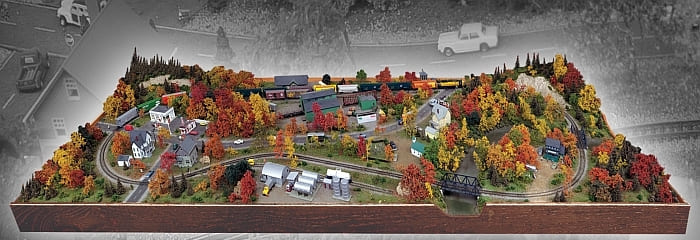
LEGO CITY PLANNING – TYPES OF TRAINS
Logically, trains should be “going someplace” and “doing something”. That means, the tracks should be configured to go “off the layout” or what model railroaders refer to as going to “staging”. There are several types of train systems:
- Commuter Passenger Trains – These trains start at the edge of the city, make stops at stations along the way, and typically end up in midtown. (LEGO issues a new passenger train every few years.)
- Interurban Passenger Trains – These take passengers between cities. At the minimum, there needs to be two stations, one in each city. Historically, these would be big, old, and fairly ornate stations.
- Freight Trains – These trains pick up merchandise someplace and drop it off someplace else. For example, they might pick up coal by a mine and take it to a generating station. Or they might pick up fresh produce (in refrigerated cars) and take it to a major city, where trucks then distribute the produce to local stores. Very often, they might bring raw material (i.e. steel) and parts to a factory and then ship out the finished products (cars and trucks) in other types of freight cars to different parts of the country. (A car factory could take up a large size LEGO layout by itself.) There are plenty of LEGO cargo trains issued through the years.
- Excursion Trains – These trains are very often old steam engines with coal tenders, that start in a station, take tourists out to see the scenery, and bring them back – often with a small museum at the start and no station at the other end.
- Theme Park Trains – These trains take tourists around the park. The bigger ones have at least two stations as well. Some are notable for their open viewing cars.
LEGO CITY PLANNING – TRAIN TRACKS
Once you select your trains, you need to consider their layout. The train circling your entire city is presumably on your main line. A siding or passing siding comes off the main, runs parallel to it and then rejoins it. It just takes a set of LEGO points/turnouts to accomplish this. You can place your passenger station on a siding, so a freight train can pass when the former is loading and unloading passengers. At the minimum, your design needs at least two stations, so a minifigure can board at one and disembark at the other.
There should also be interchange tracks where cars can be switched from one railroad to another. It’s as simple as using one point so that the train goes onto a different track that might really go just a short distance before disappearing into a tunnel (wall, dead end). Highway overpasses, trees with overhangs, or tall buildings are all ways of hiding that the train (or a road) is really going nowhere.
There are also spur lines going off the main line to local factories. Again, this just takes a LEGO point. The factory can be right there, some distance away on the spur, or just be in your imagination. To give you an example, I have a track that comes out of a tunnel (the wall) and has sidings for three factories before ending up by a fourth. A small shuttle engine services the line and there are usually freight cars parked on the sidings. A small passenger car brings workers into the industrial zone.

There are still cities that have train tracks running down the center of the street. (If I remember correctly, Lexington, KY is one, as does Ashland, VA) Paul Dolkos (Model Railroader Magazine, October 2017) offers lots of details. He even has a train boxcar sticking out of a factory building. The catch is that it’s really just half a car – the visible half. Someone else cut a passenger car in half and has each half sticking out of a service station garage door. (It helps the budget.)
There need to be train stops, bumping posts, and wheel stops at all these dead ends. They come in many varieties (Model Railroader Magazine, March 2009). The simplest is just to pile dirt and/or spare ties at the end of the line.
If you have the space, include changes in elevation on your train (Classic Toy Trains Magazine, May 2016). If one track can pass over the other, it looks great and adds possibilities to the layout. (LEGO did make at least one nine volt track crossover.) Remember that elevations take a lot of space.
LEGO CITY PLANNING – SERVICING TRAINS
Trains need service areas. A modeler named Stan Trzoniec has written articles on such facilities, like a sand tower (Classic Toy Trains, November 2017), a maintenance platform (Classic Toy Trains, September 2017) that can service either one or two tracks, and detailing a modern engine house (Classic Toy Trains, September 2014).
Train lines also require service trucks. I came across a heavy-duty one in the February 2010 issue of Model Railroader Magazine that has a removable generator and compressor loaded on the back. Pickup trucks are useful as well. LEGO made several train service vehicles in the past that could travel on tracks or roads.
Trains also require little work storage sheds in different locations. Very often, a rail company would use same colors for train engines, buildings, and trucks. Older trains had handcars for crew to ride around and carry tools. They’re outdated, but cute, so I have one on my own LEGO layout. You could also build for it a small shed for parking (Model Railroader Magazine, March 2009). I have several cabooses as well, also outdated, but cute.
You could also consider building a locomotive parked by a work platform with the service doors open revealing the engine being worked on.
A transfer table allows trains to be moved between tracks in a railroad shop. It takes lots of space, but less than an old-fashioned roundhouse. Look for a Walthers’ catalog online if you have any interest in trying to build one out of LEGO.
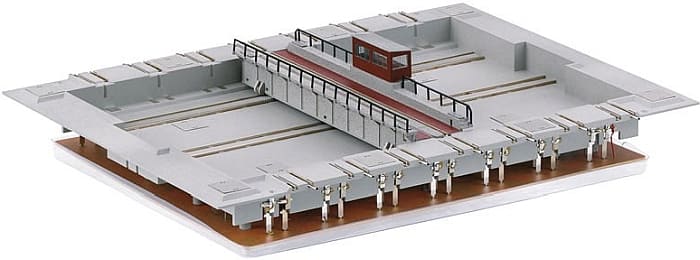
Passenger train stations ranging from simple platforms to a Grand Central Station regularly show up in train magazines. Look at the October 2009 issue of Model Railroader for how much you can do with a simple platform. Seats, sandwich signs, lights, trashcans, advertising posters, a few cabs parked nearby, all add to the scene. Renowned hobby photographer V.S. Roseman points out that people in motion “are useful for representing action along the platform. However figures in extreme action poses tend to appear artificial” (page 36). The same applies to other parts of the layout as well.
A station or extension canopy will make your station appear longer. Because many were added later, they can be a different color. Some train platforms are even just cement slabs or wood built at ground level with little or no shelter for passengers. Some have crosswalks so passengers can cross between platforms.
Have you considered a trolley? I built a small open sided one with an engine that runs on my metal train tracks. Because of its construction, it is very fragile, but people seem to think it’s cute. A spectacular trolley layout set in New Haven, CT was featured in the September 2010 issue of Model Railroader. Its city scenes, including part of Yale University, look real.
Trains, especially LEGO trains, make wide turns. What to put in the corners is always a question. One idea in the June 2009 issue of Model Railroader suggests adding a hill or rock cut in the corner. The rock cut allows one to build steeper in less space. Put a little greenery and a couple of trees on top. It breaks up the flat surface, and suggests the layout continues. Someone else put two longer narrow cuts with the tracks coming between them.
A train disappearing from view and then reappearing adds interest. A hill or tunnel does the job. In a city, the track can disappear behind tall buildings or flats.
LEGO CITY PLANNING – INDUSTRY & FREIGHT TRAINS
Many trains today carry containers, They should originate “somewhere”. For your own LEGO train layout, how about a waterfront? Very often, these trains go to a transshipment warehouse where the loads go from train to truck/trailer. Why not build such a facility? Containers can go in sunken center cars (LEGO sold a TTX pair years ago) or on flatbed cars. They can be piled two high. Containers are typically 20 or 40 feet long.
Menards, the Midwest home improvement chain, got into the model train business several years ago and offers really nice prebuilt models that I’ve tried to mimic in LEGO. Menards just came out with a Schneider’s Shipping Building, in orange. I have all these orange LEGO bricks that I don’t know what to do with! I just built (the front half of) the model, together with an orange container. (See Classic Toy Trains Magazine, May 2020 for both a review and a big picture advertisement.)
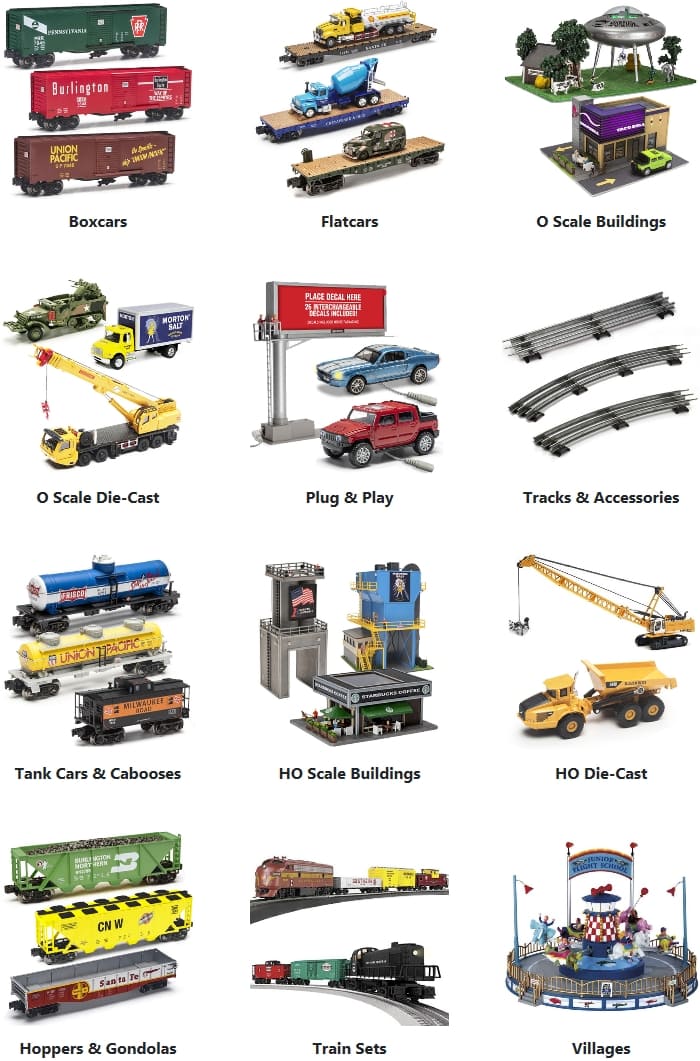
The same company has a popular power plant that I’ve copied in LEGO. It’s blocky, but maybe that’s what power plants are. Menards has two versions, tan and grey. Others have built LEGO power plants complete with different colored pipes and electrical equipment.
Menards has other ideas that I haven’t seen from others. Examples include a Morton Salt factory that I’m trying to build, and a Pepsi Cola distribution Center. You don’t really need trains or tracks for these ideas (Classic Toy Trains, December 2019 includes a Menards catalog). The August 2010 issue of Model Railroader has an article on modeling a transloading terminal. Another article suggests taking a photo of stacks of containers and using it as a backdrop to make your terminal seem much larger (Model Railroader Magazine, April 2010). The author actually put some model containers on their side on a color photocopier and used that for the backdrop. The June 2010 issue of Model Railroader describes building a four-track intermodal yard with a intermodal crane. (LEGO has sold several cranes over the years.) The closest LEGO has come is probably the #6391 LEGO Airport Cargo Center and #6377 LEGO Air Delivery Center.

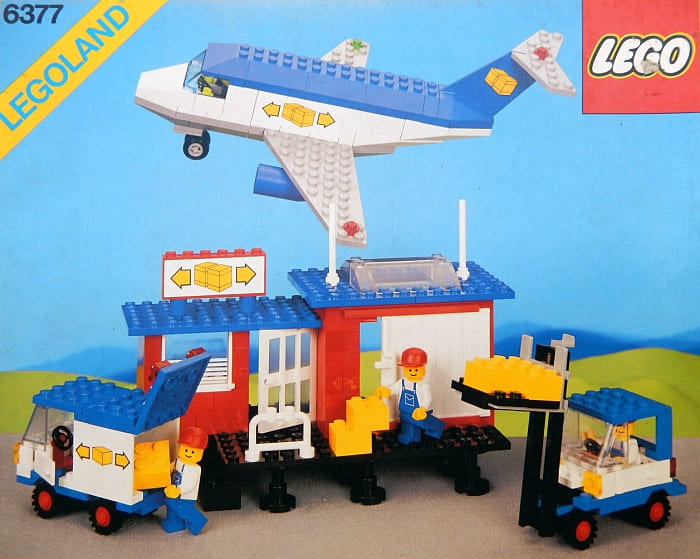
Ethanol production is apparently a major modern Midwestern industry served by railroad. Its factories are huge. But you can build just the front parts with the back to a wall. Simple building! Again, look in the Walthers catalog for their non-LEGO models. The February 2010 issue of Model Railroader illustrates how to condense an ethanol factory complex. Steel mills offer similar possibilities and complications.
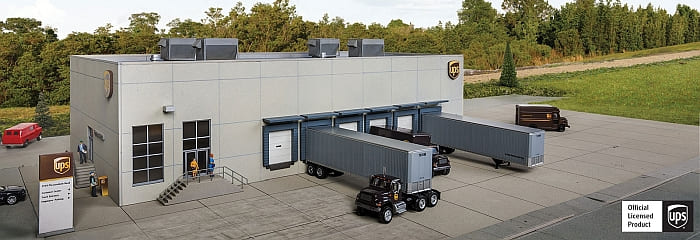
Walthers also issued a series of buildings in late 2017/2018 under license from UPS. There’s a large shipping building with six loading doors and a UPS store. There are also several trucks and trailers to service the facility. Don’t like UPS? FedEx, anyone? Lots of folks have LEGO stores on their layouts. How about a LEGO factory serviced by truck and/or train? The October 2000 issue of Classic Toy Trains has a model of a Lionel factory and office (in Lionel Orange) that can be easily built out of LEGO, and modified to different colors.
Looking for “modeling space saving industries”? The April 2020 issue of Model Railroader has a half dozen interesting ideas.
LEGO CITY PLANNING – OTHER IDEAS TO BRING TO LEGO
If you have any interest in taking photos of your layout, Model Railroader has occasional articles on the subject.
Want to install lights in your trains or buildings? Check out the June 2009 issue of Model Railroader. As the LED technology improves and gets smaller, model magazines have articles on how-to subjects. Wires or connectors exposed? The November 2016 issue of Classic Toy Trains offers suggestions of how to hide them; put a garbage can or dumpster on top!
Interested in room lighting? Background scenes? Train operations? Model Railroader, Classic Toy Trains, and other magazines regularly cover these topics.
Signs: how to find them, make them, and print them is another topic. What font should you use for your train equipment and stations? Look at the September 2017 issue of Model Railroader.
You might also consider creating a newsletter for your city or railroad (Model Railroader, June 2009). Today, this would be shared by email. One can also argue that all the YouTube LEGO city updates are just a modern version of newsletters. But as you can see from my articles here, I’m still a fan of the printed word.
Dust makes it hard to keep your layout clean? Look at the June 2012 issue of Model Railroader for some ideas.
Bench work is its own topic. I’ll just say that many train layouts are not rectangular. Being able to build below your layout level is always an advantage. Besides the use of water, consider subway entrances (without the subways). Look for example at Robin Hood Bricks’ YouTube channel. Just a small crew digging up the street is another way of adding action to a layout. Most model layouts have foam on top of their plywood base. That foam can easily be cut away. View-blocks to separate scenes are also useful. They can be actual walls, a line of tall buildings, some hills, or tall trees.
Big, wide layouts mean it’s hard to reach the middle. The average outstretched arm can reach about 20-24 inches. Some layouts therefore have one or several lightweight lift-out panels (Model Railroader, March 2010). I don’t consider myself knowledgeable on most of these things.
LEGO CITY PLANNING – CONCLUSION
My favorite Model Railroader author, Tony Koester, often preaches that much of the world is plain vanilla, and therefore most of our structures should reflect that reality (Model Railroader, October 2010). He believes most of the buildings on train layouts (and presumably LEGO cities) should be white with a few tans and greys thrown in. He argues that an entire string of red boxcars is more realistic than every car being a different color. Really ornate, gold, or multi-colored buildings should be left for our model amusement parks. But Tony would agree that the ultimate goal is to have fun.
Railroad magazines are certainly not the only source of ideas. Just look on the internet. I hope you have both enjoyed and learned something from this series. Thank you for coming along on this trip. I would really enjoy hearing from you with your feedback and comments. Happy building!
And you might also like to check out some of my previous articles:












Hmm, there seems to be many German companies involved in the model train and model toy business. For an American, I guess they could be too focused on local German / European culture, though.
My biggest issue with train layouts is how much space they take up. Even just doing one loop has to be like 3-4 feet wide. Length is not a problem, but I don’t have that much width available for a permanent layout.
I think there was some old trick of using shelves around a whole room, if you’d manage some engineering feat beforehand…
There’s no “engineering feat.” Simply put tables against the walls around two — four walls. You could also use bookcase tops and put books or storage on the shelves. If the layout is high enough, you can even have part of it run 12-18 inches above a desk.
Some folks have shelve layouts with one or two extra ‘islands’ coming into the center of the room.
Personally, my layout is on 4 -5 levels: the floor and then shelves circling around most of the room. The only place LEGO tracks take up a lot of space is in the corners where they turn.
Some of those models are really lifelike. I thought the UPS center was a real picture!
So try building it out of LEGO. You could limit it to 2-3 truck spots to save space if necessary. I’m sure there are UPS (or FedEx) logos to be found on the internet. The trucks are standard tractor trailers. If needed, find instructions for the old LEGO truck and change the colors. Build it against a wall, and you don’t need to make it so deep. It seems like a simple, straight-forward project that doesn’t require specialized pieces and would make a city layout unique.
Wow! Not to get off subject, but they even have a UFO! I wasn’t even aware of these model trains, and have never seen them anywhere. Are they only sold online?
Online, with free shipping to a local Menards store for pickup.
Holiday time, stores carry a small selection.
I’m afraid that if I get into trains I won’t be able to stop. It’s an expensive hobby. But then I read articles like this and I really want to do it. Sigh.
The well presented information about categories and strategies is great – the details fascinating…but like Henry III, not sure I should get started on that ride 🤪
Thank you.
A starter lego train is about $200; extra track is also not cheap. And a layout takes SPACE. The advantage of LEGO is you can easily put togrther a train layout on the floor or dining room table for the visiting kids, and quickly take it apart when the kids go home. (A train station or houses can go on a display shelf until the next visit.)
So interesting. For trolleys and trains that run on overhead wires, how do you do that in Lego?
Wires are a tough job.
Many train modelers, for example, have telephone poles without the wires. I think some company started selling “pre-hung” wires for telephone poles.
There are trolley modelers who use live wires, others get power from the tracks and use non-functional trolley wires for ‘show.’
I believe that newer LEGO trains that are battery operated don’t really need tracks except for ‘show’ and to keep the trains going in the desired direction.
I found the article interesting and quite informative.
thank you.
Wow
A very well written interesting article loaded with lots of info!
Thank you.
Fascinating! I better start saving now…my grandsons already have exorbitant LEGO requests – usually Star Wars. Lord help me if they get into LEGO trains!
Great conclusion to a series.
I found the whole series very interesting and informative.
From my own experience, I find that the roads and trains are the hardest to “fit” into the city layout. It might be best to plan the layout of those two and then work your city around them.
Look forward to your next series!